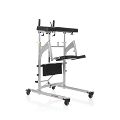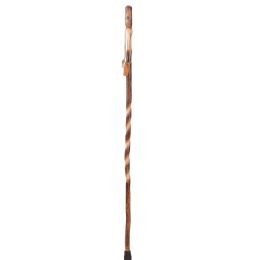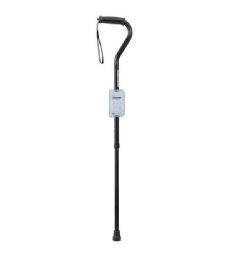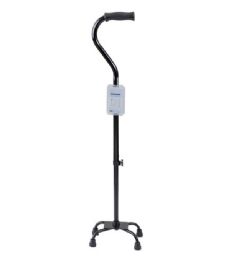
A walking aid is a device designed to assist and improve the motility of those with mobility impairments. There are many types of walking aids that can help people who have a difficult time getting around.
Rehabmart is proud to carry several different types of walking aids from respected vendors that encompass Walk Easy Inc., Posey, LSS, Drive Medical, Step Dynamics, Trionic, Clarke Healthcare and Skil-Care.



What are Walking Aids?
Walking aids are a great way to enjoy life in a way that is independent and secure while providing a source of exercise essential to a healthy lifestyle. People need walking aids for a variety of reasons; shortness of breath, arthritic pain, fear of falling, inability to walk and carry objects at the same time, poor balance, fear of being alone, social isolation, recovery from surgery or injuries, and a host of disabilities.
Walking aids are usually required for one of two purposes; as part of a rehabilitation program when recovering from an injury or operation, or as a long-term aid for mobility when someone has permanent difficulty with walking. The rehabilitation process is a gradual one towards unassisted and independent walking, and may begin with one type of walking aid to give confidence before progressing to another type of walking aid. The ultimate aim is to be able to walk independently without any walking aid at all. But, complete recovery is not always possible or a disability or illness can permanently affect the legs, coordination and balance. Mobility equipment may be required for long-term use in these situations.
Deciding on what type of aid to purchase depends on personal priority, lifestyle, tasks to be completed, and budget. For some users, the reason for choosing a walking aid is easy. However, there is often a complex mixture of reasons for needing a walking aid. In those cases, a therapist can help in determining the correct one to choose to fulfill specific requirements.
What are the Different Varieties of Walking Aids?
Walking aids include assistive canes, walkers and rollators. These devices help to maintain upright mobility by providing improved stability, reduced lower-limb loading, and the initiation of movement. The cane is the simplest form of a walking aid, held in the hand to transmit a person’s weight to the floor through the shaft. A walker is the most stable walking aid and consists of a freestanding metal framework with three or more points of contact on the floor. A rollator, a walker with wheels, is the easiest to maneuver, and additionally assists with weight-bearing and balance.
Which Walker is Right for Me?
Walkers and rollators come in a variety of frame shapes, adjustable heights and folding or non-folding formats, with choices of varying features such as with or without wheels, and differing types of brakes, molded handles and seats. Walkers refer to the simple frames that are mainly used indoors and provide basic stability. Rollators describe the 4-wheeled frames that include brakes, baskets, a seat and large casters. The goal is to choose the walker that provides the best mobility in the most situations without sacrificing safety. If a walker is needed for fatigue and decreased endurance, the most maneuverable walker (the rollator) could be the correct fit. If an individual is unable to place weight through the legs, then the basic walker without wheels could offer more stability. Be sure to consider balance difficulties along with levels of pain, shortness of breath, muscle weakness and speed of walking.
How Do I Use a Non-Wheeled Walker Safely?
A non-wheeled walker requires users to use a start/stop style of walking, and they need to be strong enough to pick it up and place the walker with good balance. This type of walker helps control speed if they have a tendency to speed up their walking, or if they have a tendency to fall forward. There are four main activities that are needed to be performed safely when using a walker; standing up, sitting down, walking, and turning. The following are intended as general guidelines and may not be appropriate for everyone. Therefore, seek specific guidance from a professional healthcare therapist for more personalized suggestions relevant to your specific situation.
When preparing to stand up, move forward and sit as close to the edge of the chair as is comfortable. Keep the feet as far under the body as possible, aiming to place the toes directly below the edge of the chair. Place both hands on the arms or seat of the chair, or, place one hand on the chair and one hand in the middle of the walker frame. Do not place too much weight on one side of the walker while standing or it may tip. Lean forward until feeling some weight on the feet. Use the legs to stand as much as possible, using the arms mainly for balance and to lift only what the legs cannot. Do not walk forward until balance has been tested and you are feeling strong enough to walk.
When preparing to sit down, stand directly in front of the chair, facing away from it with the back of the legs almost touching it. Move the walker a little bit away to allow a slightly forward bend when sitting down. Reach behind for the chair, preferably with both hands, or reach with one hand with the other hand on the walker. Using the legs, slowly lower to the chair.
When walking, first place the walker ahead to allow enough room to take each step. Never take any steps while holding the walker off the ground. If a person’s steps are uneven, they should try shortening the longer step to match the shorter step. Then, move the walker forward after taking a step with each leg.
When turning, it should take about 2 to 3 individual steps to make a 180 degree turn. First, place the walker towards the direction you want to go. Do not take any steps while moving the walker. Step the feet around until they are facing the walker. Repeat the process until you are facing the direction you want to walk. Do not twist with the back when turning, this can cause a loss of balance.
What are Some Common Mistakes to Avoid When Using a Walker?
There are common mistakes therapists often see users making with walkers that can be avoided. They are:
• Carrying the walker instead of placing it on the ground when taking steps.
• Starting to sit while still turning in front of a chair.
• Taking uneven steps.
• Holding the walker too close or too far away while taking steps.
• Forgetting to use the walker, or walking away from it.
• Holding the walker with both hands while standing up or sitting down.
• Leaning too far away from the walker’s base of support.
• Twisting away from the walker while turning.
To help an individual, guide their body forward while keeping their weight over their feet and do not pull through their shoulders or arms.
How do I Use a Rollator Safely?
A rollator, a wheeled walker, allows for a smoother walking pattern due to how easy it rolls. It requires the least strength and least exertion to move because of its larger swivel casters. A person must be able to control their walking speed, and also have the ability to coordinate the action of the brakes with their steps if needed. A rollator may be beneficial for those who have balance problems. There are four main activities that need to be performed safely when using a rollator; standing up, sitting down, walking and turning. The following are general guidelines and may not be appropriate for everyone. It is important to enlist specific guidance from a healthcare professional for more personalized assistance.
When preparing to stand up, first engage the brakes. Move forward and sit as close to the edge of the chair as is comfortable. Keep the feet as far under the body as possible, placing the toes directly below the edge of the chair. Place both hands on the arms or seat of the chair, or, place one hand on the chair and one hand in the middle of the rollator frame. Do not place too much weight on one side of the rollator while standing or it may tip. Lean forward until you feel some weight on the feet. Use the legs to stand as much as possible, using the arms mainly for balance and to lift only what the legs cannot. Do not walk forward until balance has been tested and you’re feeling strong enough to walk. Then, disengage the brakes.
When preparing to sit down, stand directly in front of the chair, facing away from it with the back of the legs almost touching it. Do not begin to sit until you’re standing still and balanced. Move the rollator a little bit away to allow a slightly forward bend when sitting down. Engage the brakes. Reach behind for the chair, preferably with both hands, or reach with one hand with the other hand on the rollator. Using the legs, slowly lower to the chair.
When walking, place the rollator ahead to allow enough room to take each step. Move the rollator gently ahead while walking, keeping it close enough for support. If your steps are uneven, try shortening the longer step to match the shorter step because the shorter step tends to have less balance.
When turning around, stay within the width of the rollator even if slightly behind it. Roll it around without twisting the back, keeping the body facing the front of the rollator.
What are Some Common Mistakes to Avoid When Using a Rollator?
There are common mistakes therapists see users make with rollators that can be avoided. They are:
• Not engaging the brakes when standing or sitting.
• Beginning to sit while still turning in front of a chair.
• Taking uneven steps.
• Holding the rollator too close or too far away while taking steps.
• Forgetting to use the rollator, walking away from it.
• Holding the rollator with both hands while sitting down or standing up.
• Leaning too far away from the support of the base of the rollator.
• Twisting away from the rollator while turning.
• Sitting on the rollator while someone pushes it. There are only certain models that allow this function.
To help an individual, guide their body forward while keeping their weight over their feet and do not pull through their shoulders or arms.
How do I Find the Right Fit with a Walker or Rollator?
Most walkers and rollators are adjustable to fit height ranges. The walking aid should support an individual while standing as tall as possible, with minimal strain on the wrists, hands, shoulders and neck. The handles should be adjusted so they are at the height of your wrists when standing with arms relaxed at the side. Depending on an individual’s needs, the seat may be adjusted lower so that feet are flat on the floor to provide stability and balance. Or, the seat can be adjusted higher to be utilized for perching and making it easier to stand up.
The width of a walker must provide clearance for an individual’s steps; therefore, if walking with feet far apart, a wider walker is needed. Make sure the grips are comfortable for stability, some have optional ergonomic handles. The wheel locking system should be easy to operate and reliable on a rollator, and can be used to slow down the speed of the rollator if necessary. Before purchasing, always check on the working weight limit recommendations for any walker or rollator.
Hulet Smith, OT
Rehabmart Co-Founder & CEO
lb